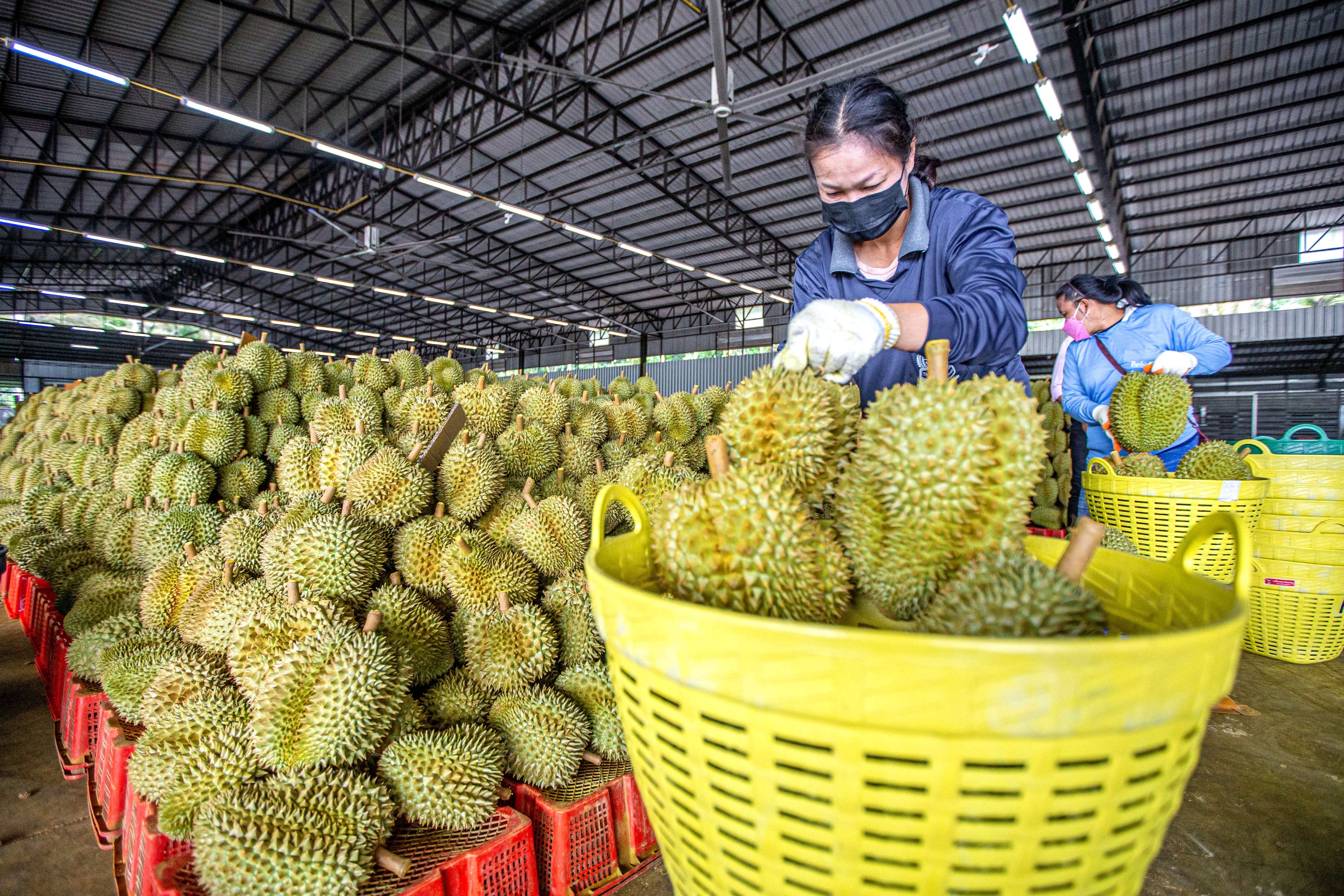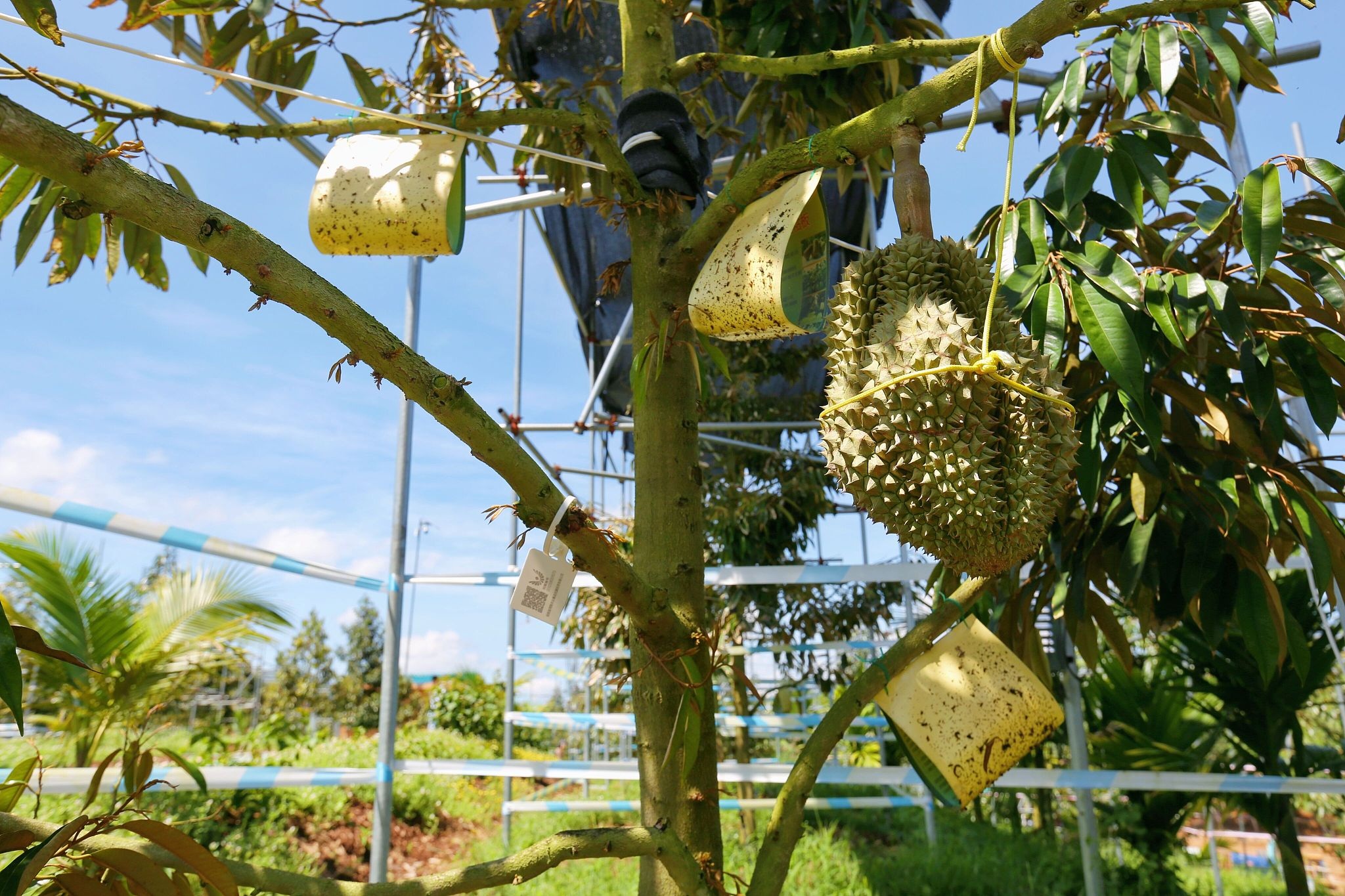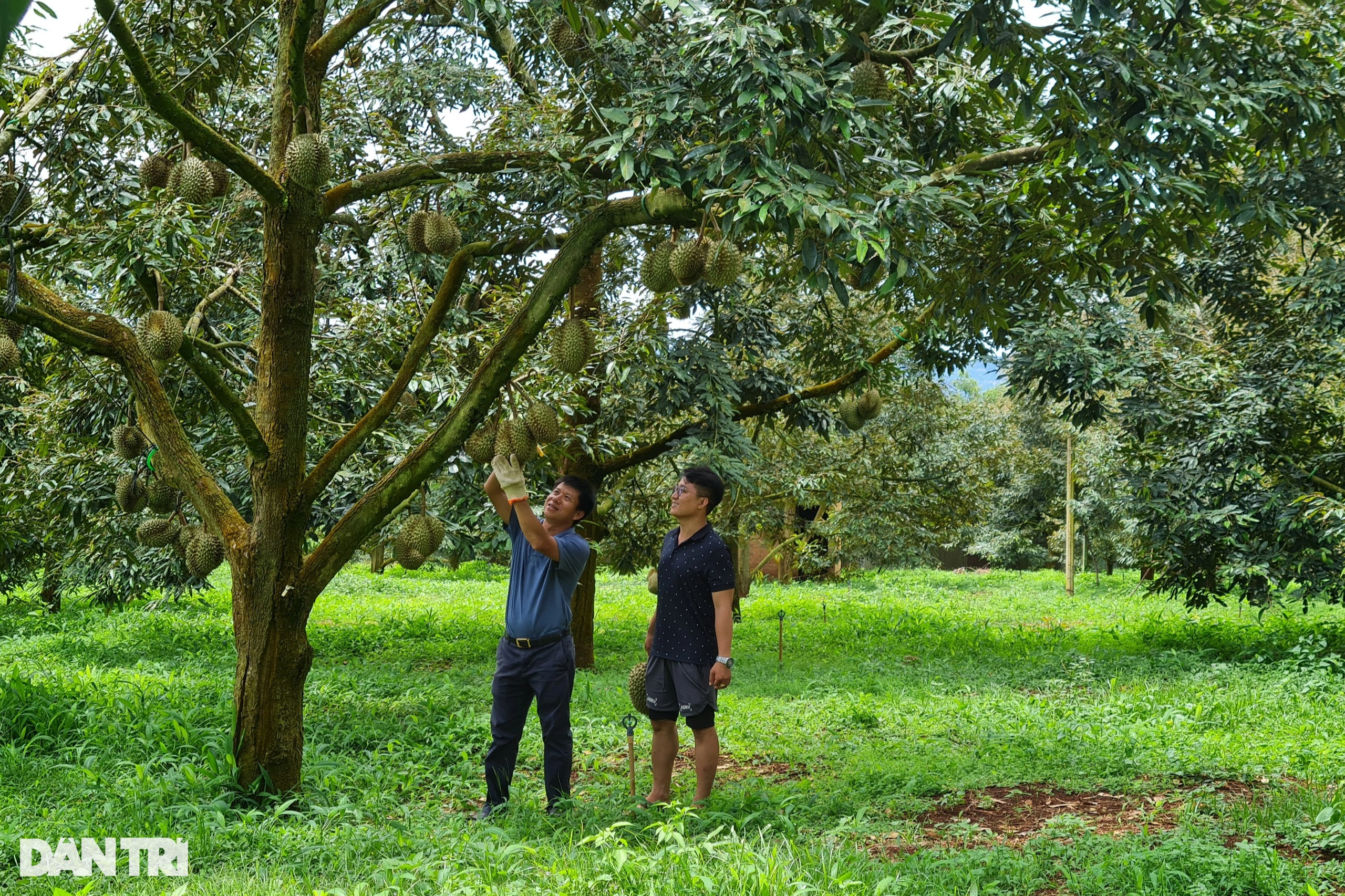Nearly a decade ago, dragon fruit was Vietnam’s “fruit export queen,” with a turnover exceeding $1 billion and continuously maintaining its position as a “billion-dollar fruit” until 2021. But after just one year, this figure plummeted from $1.04 billion to $642 million.
Thousands of tons of dragon fruit were stuck at the border gate, had to turn around, and were sold off at a price of only 4,000 VND/kg. In fact, Vietnamese fruit still depends heavily on one market. When China both massively expanded its growing area and tightened its import standards, Vietnamese dragon fruit immediately fell into a passive position.
This lesson is being applied to durian, as this country of a billion people has expanded its growing areas in Hainan and Guangxi and set a series of import standards. At the same time, competitors Thailand, Malaysia, and Indonesia have increased competitive pressure. In this context, finding a solution to both maintain a position and enhance competitive value has become an urgent requirement for the Vietnamese durian industry.
Pressure from China and fierce competition
The global durian market is witnessing fierce competition between the "giants" Vietnam, Thailand, and Malaysia. Of these, Vietnam stands out with nearly 180,000 hectares of planting area in 2024, an estimated output of 1.5 million tons and an export turnover of about 3.2 billion USD.
In Thailand, durian cultivation has exceeded 163,000 hectares, producing 1.53 million tons per year, according to the Bangkok Post. Malaysia is not far behind, expanding to more than 92,000 hectares, with a production of about 568,000 tons last year.
Meanwhile, China has just entered the race with about 20,000 hectares of durian plantations, with domestic output expected to be nearly 2,000 tons this year, according to Sohu. However, with an average yield of 40-50 fruits per tree, bringing in a production value of 1.2-1.5 million yuan per hectare, Chinese businesses predict that their durian will soon become a new “hot spot” in Chinese agriculture , according to Xinhua.

The global durian market is witnessing fierce competition between the "giants" Vietnam, Thailand, and Malaysia (Photo: SCMP).
Not only expanding durian growing areas in Hainan and Guangxi provinces, many Chinese businesses have also flocked to Laos - a landlocked country with an ideal climate, low labor costs and large areas of land to develop durian growing areas, aiming to export this fruit to China, according to Nikkei Asia.
In October 2024, a group of Chinese enterprises had a meeting with representatives of the Lao National Chamber of Commerce and Industry, along with leaders of the Lao Ministry of Agriculture and Forestry and the Ministry of Industry and Commerce to discuss this issue.
The Chinese business group proposed establishing a specialized agency including a Business Association, a Professional Association and a Durian Research Center to manage the entire process from variety selection, cultivation techniques, quality control to logistics.
These organizations will support farmers in selecting varieties, preventing pests and diseases, researching and developing new varieties, and providing technical guidance on soil analysis and the use of biological fertilizers...
In Cambodia, some Chinese companies have also invested in growing and processing durian in the country for export to China. In Battambang city (Cambodia), a large corporation from China has cooperated with local businesses to develop a durian garden of more than 160 hectares.
Are Thailand, Vietnam, and Malaysia concerned about China growing its own durian?
Faced with China’s ambition to grow its own durian on Hainan Island to compete with Southeast Asian countries, many experts in Vietnam, Thailand, and Malaysia believe that the country’s tropical fruit will not be able to replace imports anytime soon. They say that China’s domestic durian cultivation does not pose any significant concerns.
Mr. Sam Sin, Development Director of S&F Produce Group based in Hong Kong (China), said that durian grown in China still cannot compare with Thai durian in terms of quality due to unsuitable climate conditions, according to SCMP.
Sharing with Spring News, the owner of a durian garden in Trat province (Thailand) also assessed that China growing about 2,000 tons of durian domestically is a very small number compared to the 500,000-700,000 tons of durian Thailand exports each year, so it is not a cause for concern.

A durian farm in Sanya city, Hainan province, China (Photo: CFP).
This garden owner believes that the more worrying reality is the quality of Thai durian and the export of young durian. If not well controlled, the market and prices will be affected.
Lim Chin Khee, a durian expert in Malaysia, said he has to fly to China every two months to instruct Chinese farmers on durian growing techniques. However, he believes that domestic durian production is still not enough for this billion-people market to reduce imports in a short time because farmers here have to rent land and weather conditions are erratic.
However, this expert said that Malaysia, Thailand and Vietnam still need to regularly monitor the development of China's durian industry, because it is possible that this country will become a strong competitor in the market when farmers' technology and cultivation techniques are improved.
Sharing with Dan Tri reporter, Mr. Nguyen Van Muoi - Deputy General Secretary of the Vietnam Fruit and Vegetable Association - also said that China's domestic durian output is currently only about 2,000 tons - a very small number compared to the actual needs of the people of this country.
He said that China is not a country with favorable conditions for growing durian, because the Hainan island area is often affected by storms. In particular, durian trees bear a lot of fruit, so it is difficult to withstand storms.
"China's self-cultivation of durian is not a cause for concern. What is noteworthy is that Chinese enterprises are stepping up investment in durian cultivation in Laos and Cambodia. In fact, Chinese enterprises have invested quite a lot in durian cultivation in Laos," said Mr. Muoi.
The problem of Vietnamese durian
Mr. Muoi said that this year, Vietnamese durian has faced many difficulties. Unstable quality combined with China's tightening of quarantine and food safety regulations has hindered exports. Durian prices have also plummeted due to many fruits that do not meet export standards being sold in the domestic market.
"The rainy weather, substandard basic growing techniques and inadequate production processes have led to many durians being unripe," he explained. In fact, most of the durian acreage is currently owned by small households, making it difficult to control quality and maintain standard growing processes.
According to Mr. Muoi, to maintain its competitive position, the most important thing for the Vietnamese durian industry today is to improve quality. The area of durian in Vietnam has grown very quickly to 180,000 hectares, so it is necessary to limit the expansion of area and focus on improving quality.

To maintain its competitive position, the most important thing for the Vietnamese durian industry right now is to improve quality (Photo: Thuy Diem).
"Durian is a special tree, requiring high techniques from flower processing, fruit setting, care to fruit quality. However, the knowledge and experience of the majority of Vietnamese farmers currently do not meet the requirements. Therefore, it is necessary to strengthen agricultural extension, organize many training courses, share practical experiences from good farmers and successful models," said the Deputy Secretary General of the Vietnam Fruit and Vegetable Association.
Besides, he said that it is necessary to build and popularize basic production processes, for example, how to handle flowering and fruiting, to limit the situation where each farmer does things differently, causing differences in quality.
To maintain the position of Vietnamese durian, the Import-Export Department ( Ministry of Industry and Trade ) also believes that export enterprises need to focus on improving the quality and freshness of the product. The Chinese durian market is still very large and there is room for both domestic and imported durian to coexist.
The agency said durian exports have been buoyant again, not only to the Chinese market but also to Thailand. Key durian growing regions such as the Central Highlands and the Southeast - where cadmium contamination is low - have helped more durian products meet export standards. At the same time, businesses have also proactively checked the quality of the orchards and tightened purchasing and packaging processes.
Mr. Nguyen Quang Hieu, Deputy Director of the Department of Crop Production and Plant Protection, said that Vietnam has formed and developed many concentrated durian growing areas with quite large output with two main export varieties Ri6 and Dona. At the same time, the number of growing area codes and durian export packaging facilities has increased significantly; the advantage of spreading out the harvest season production can provide fresh fruit for a long time, many seasons in a year.
Recently, the Department of Crop Production and Plant Protection has also implemented many synchronous solutions to promote durian exports, including: Building standard cultivation and harvesting processes suitable for climate change, perfecting the legal framework for managing growing areas and packaging facilities.
Regarding frozen durian - a product group with strong growth potential, he said the management agency has organized many training sessions to guide new regulations of importing countries, helping businesses and farmers update quickly and in the right direction.
Recently, the Department of Crop Production and Plant Protection has proposed that fresh durian (for export and domestic consumption) be divided into 3 grades according to national standards. In addition to pressure from Thailand, China will soon open its doors to durian from Indonesia. The leader of the Department of Crop Production and Plant Protection noted that the domestic durian industry needs to pay special attention to ensuring the quality and technical standards of the importing country.
The Ministry of Agriculture and Environment has also issued the Food Safety Control Process for Fresh Durian for Export (effective from August 4). Accordingly, the food safety control process for fresh durian for export covers everything from cultivation, harvesting, transportation to packaging and export, and requires registration, appraisal and safety certification for shipments.
Planting and packaging facilities must meet traceability standards, handle unsafe products and comply with certifications such as GAP, HACCP, ISO 22000... Exported products must meet pesticide residue limits and heavy metals according to Vietnamese standards and import market requirements, and must be labeled and listed by competent authorities.
Source: https://dantri.com.vn/kinh-doanh/trung-quoc-tu-trong-sau-rieng-loi-di-nao-cho-viet-nam-20250826035253979.htm



![[Photo] National Assembly Chairman Tran Thanh Man receives Cambodian Senate President Hun Sen](https://vphoto.vietnam.vn/thumb/1200x675/vietnam/resource/IMAGE/2025/9/1/7a90c9b1c1484321bbb0fadceef6559b)
![[Photo] Chu Dau Ceramics – Proud of Vietnamese identity at Exhibition A80](https://vphoto.vietnam.vn/thumb/1200x675/vietnam/resource/IMAGE/2025/9/1/c62ab2fc69664657b3f03bea2c59c90e)
![[Photo] People eagerly wait all night for the parade on the morning of September 2](https://vphoto.vietnam.vn/thumb/1200x675/vietnam/resource/IMAGE/2025/9/1/0cf8423e8a4e454094f0bace35c9a392)
![[Photo] Celebration of the 65th Anniversary of the Establishment of Diplomatic Relations between Vietnam and Cuba](https://vphoto.vietnam.vn/thumb/1200x675/vietnam/resource/IMAGE/2025/9/1/0ed159f3f19344e497ab652956b15cca)
![[Photo] Solemn reception to celebrate the 80th anniversary of the National Day of the Socialist Republic of Vietnam](https://vphoto.vietnam.vn/thumb/1200x675/vietnam/resource/IMAGE/2025/9/1/e86d78396477453cbfab255db1e2bdb1)
![[Photo] General Secretary receives heads of political party delegations from countries attending the 80th anniversary of our country's National Day](https://vphoto.vietnam.vn/thumb/1200x675/vietnam/resource/IMAGE/2025/9/1/ad0cb56026294afcae85480562c2e790)
























































































Comment (0)